Across Europe’s top five leagues, there are some incredible high pressing sides. The most notable ones are a few of the world’s biggest clubs including Liverpool, Bayern Munich, Manchester City, and Leeds United, just to name a few.
Surprisingly though, none of these teams have the most intense defensive systems in the top five leagues. The true owners of that crown so far this season, are La Liga’s own Eibar. Eibar have been under the management of Jose Luis Mendilibar since 2015 and have been a persistent name in the Spanish top-flight and a thorn in the side of the league’s biggest clubs on more occasions than one.
Strangely enough, this season Eibar are fighting for their lives to stay in the division, but they have not dwindled from their defensive principles of pressing the opposition as high up the pitch as possible and currently boast the lowest Passes Allowed Per Defensive Action (PPDA) in Europe’s top five leagues.
This article will be a tactical analysis of Eibar in the form of a scout report. It will be an analysis of their defensive tactics and particularly their pressing system, which gives them the lowest PPDA in the top five leagues.
Set up and principles
Beginning with the main statistic of the article, PPDA. Currently, Eibar have a PPDA of 7.92, which is, of course, the lowest in Europe’s top five leagues and subsequently La Liga. They are also the only team with a PPDA average under 8, with their Spanish counterparts Real Sociedad and Sevilla close by.
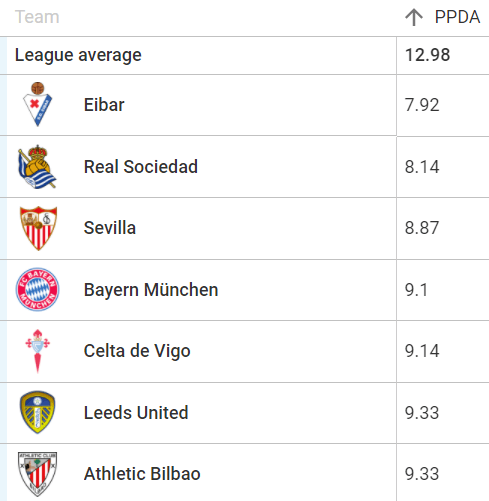
In terms of Eibar’s defensive set-up, Mendilibar deploys his team into a 4-4-2 in most games. In La Liga this season, Eibar have used the 4-4-2 in 55 percent of their games, with the very similar 4-2-3-1 being used 22 percent of the time.
When they defend in a 4-4-2, the shape does not change, but the 4-2-3-1 becomes a 4-4-2. The player playing as the number 10 simply pushes up next to the lone centre-forward to occupy the centre-backs and goalkeeper in the high press and creates a two-man first line of pressure when the opposition have the ball with their backline.
Eibar tend to only use a 4-2-3-1 when their opponents are using a single pivot in midfield. This is so that the number 10 can occupy both the centre-back and single pivot in the high press. They do this by pressing the centre-back whilst covering the passing lane to the single pivot.
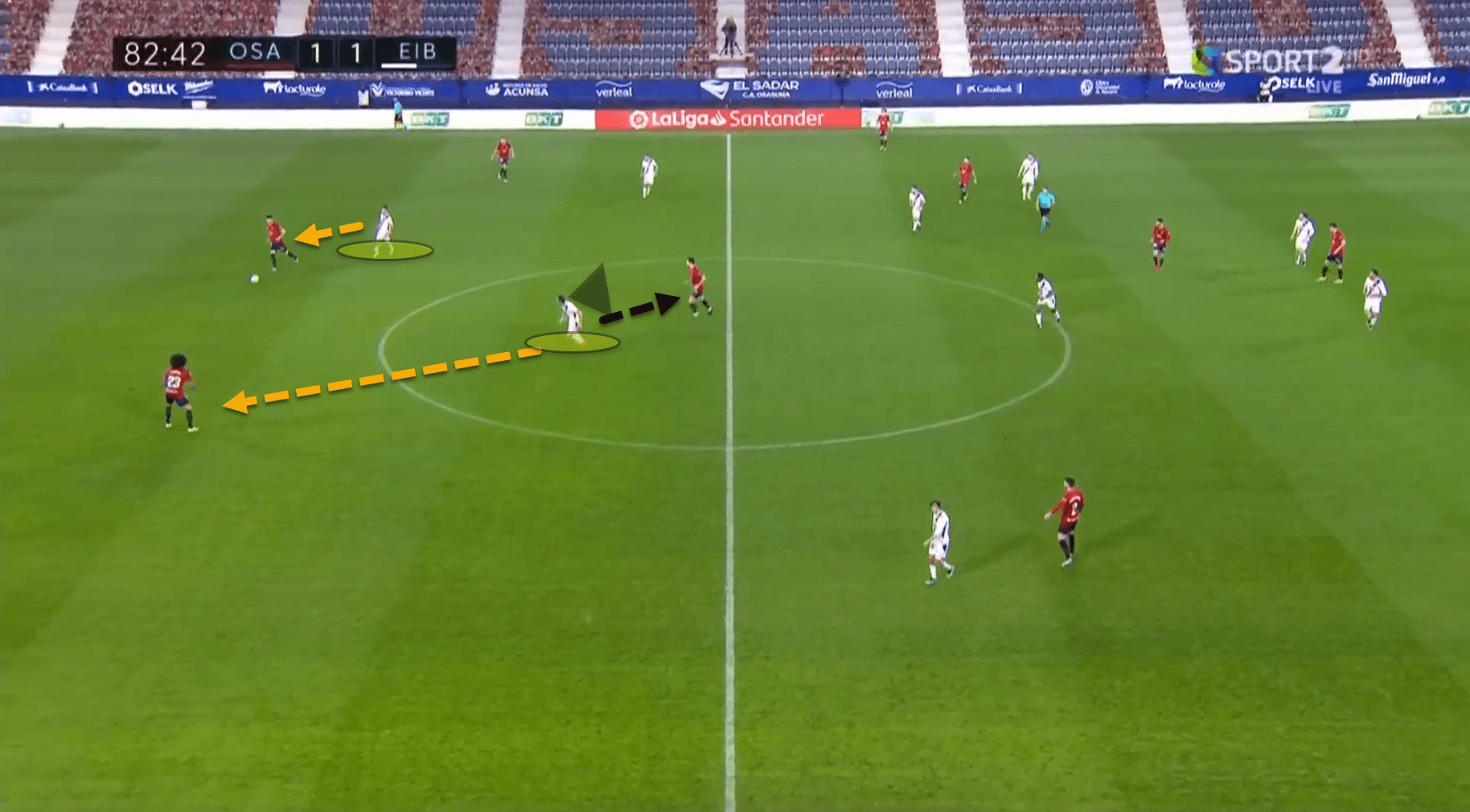
Here, we can see this in action. Whilst Osasuna have the ball with their left centre-back, Eibar’s number 10 marks the single pivot, blocking the passing lane into him. The lone centre-forward presses the right central defender, angling his run to force him to play to his partner.
When the ball is played to the right centre-back, he presses his man while applying a cover shadow on the pivot ensuring that the passing lane to him is still blocked.
Pressing in the opposition’s build-up phase:
When Eibar press the opposition in the build-up phase of play, their primary objective is to control where they play at all times and force them into the wide areas.
When high pressing an opponent, angling runs to force the ball-carrier to play out wide is essential. When this happens, the defending team can box the opponents in and use the touchline as an extra defender, limiting spaces and making it extremely difficult to play out.
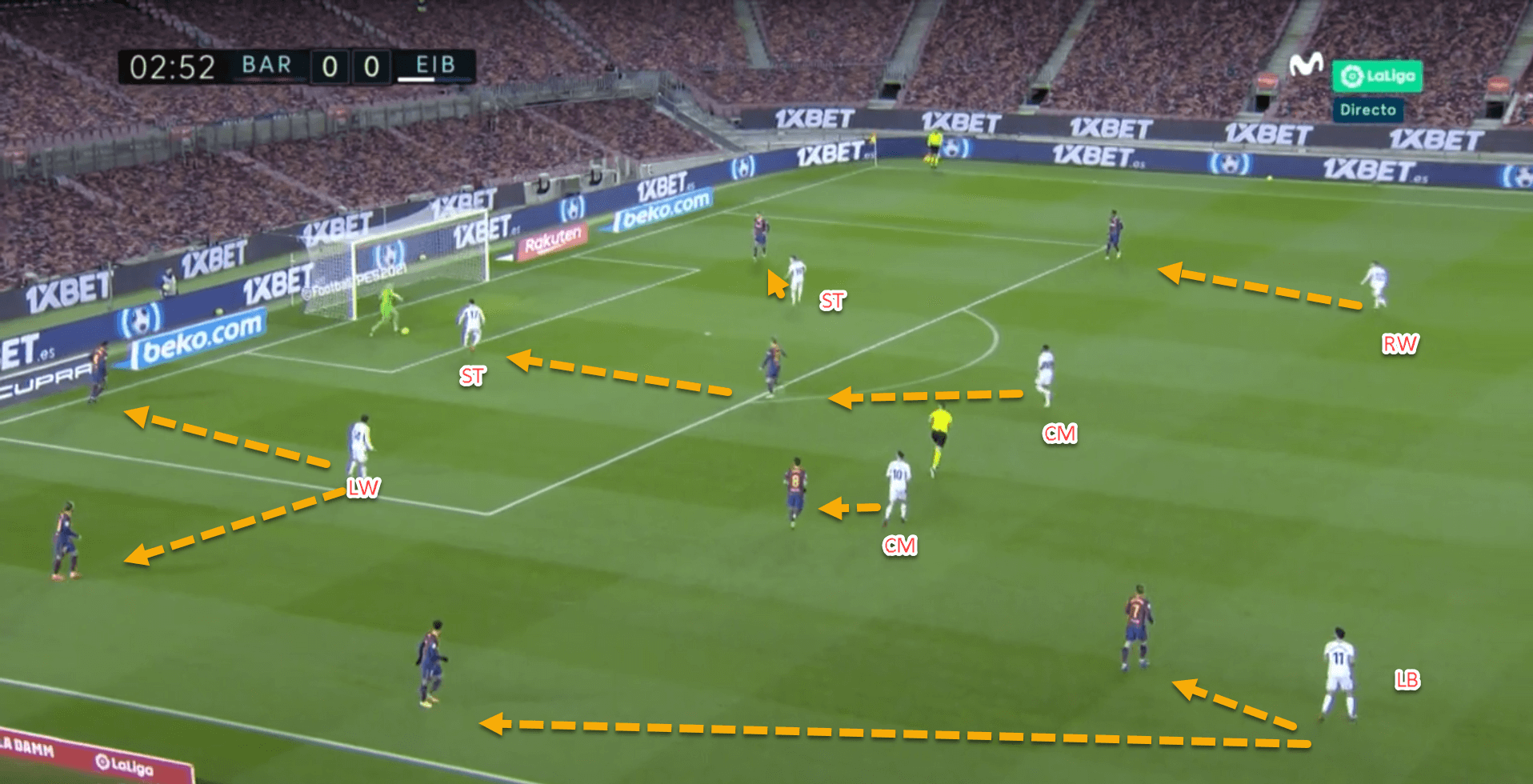
This is an example of Eibar high pressing their opponents, controlling what direction the ball is being played into by forcing them to play out wide.
The left striker has pressed the goalkeeper at an angle and has applied a cover shadow to the pivot player behind him, cutting out the central passing lane. In this image, we can see that the right striker and the right-winger already know which direction the ball is heading into and have already begun to slowly move towards their man for when the keeper plays the ball.
Since the left striker has pressed the goalkeeper, the left-winger pushes inside and marks the closest passing option to the goalkeeper on that side. This means that the left side of the pitch is free for a switch of the play if the keeper can manage to play there.
To combat this, Eibar use a shifting backline, meaning that if the ball is switched out there, he will dart out to press, whilst the other three defenders shift across to cover in unison.
The next two images will show, once again, how Eibar force their opponents into the side of the pitch, but also how they react when the ball is quickly switched to the opposite side of the field, using a shifting defensive line.
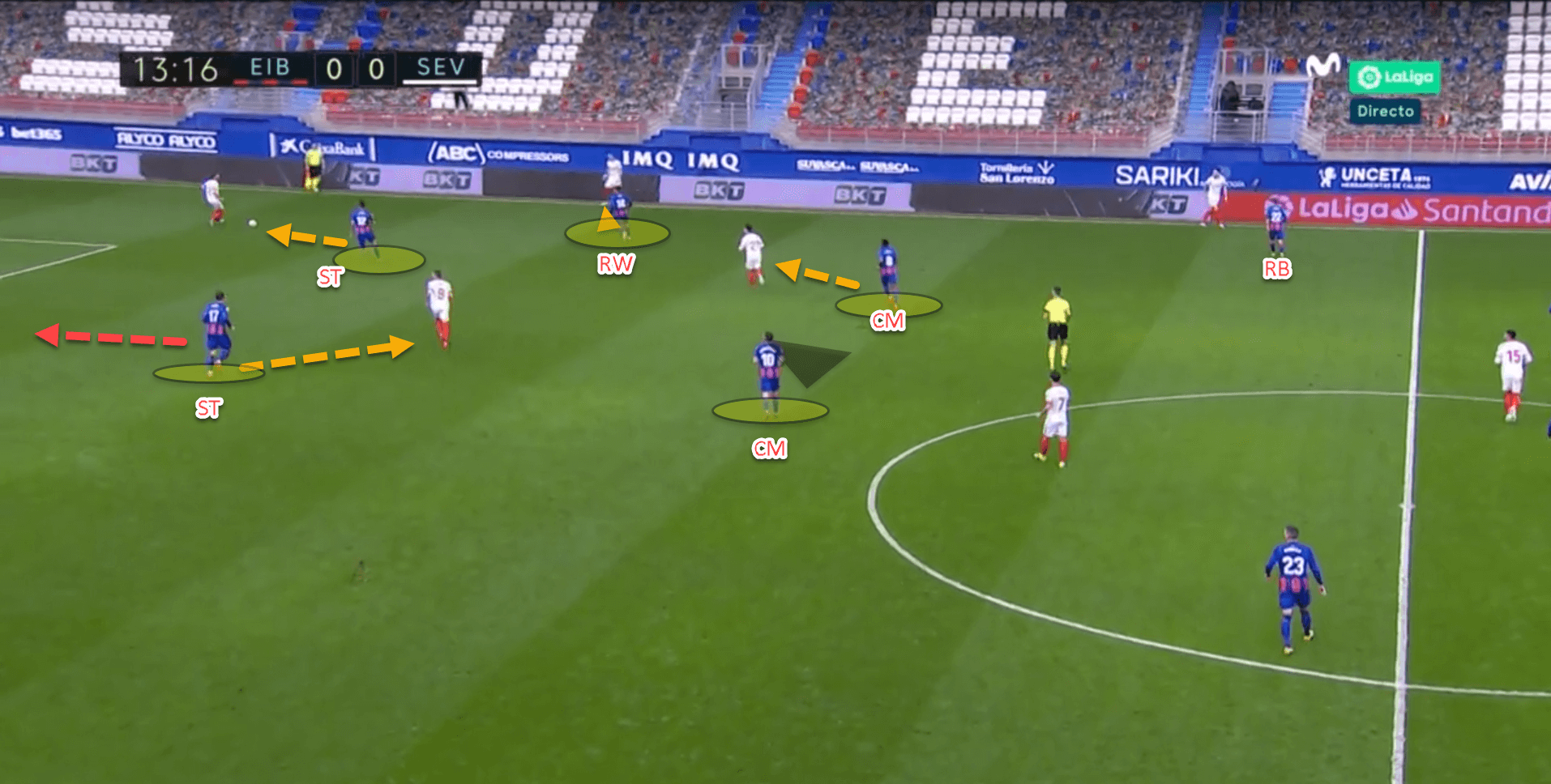
In this example, Eibar have forced Sevilla over to the defensive right flank. Once they are here, Mendilibar instructs his side to box the other team in and ensure that there are no forward or progressive passing options available by tightly marking and applying a cover shadow to all the nearby options for the opposition.
The ball-far centre-forward drops off and covers the nearest pivot player instead of the centre-back. The reason for this is so that the centre-back will be available for the team in possession to play to, which Eibar use as a trigger to press intensely on their opponent’s backline in the hope of forcing them into mistakes.
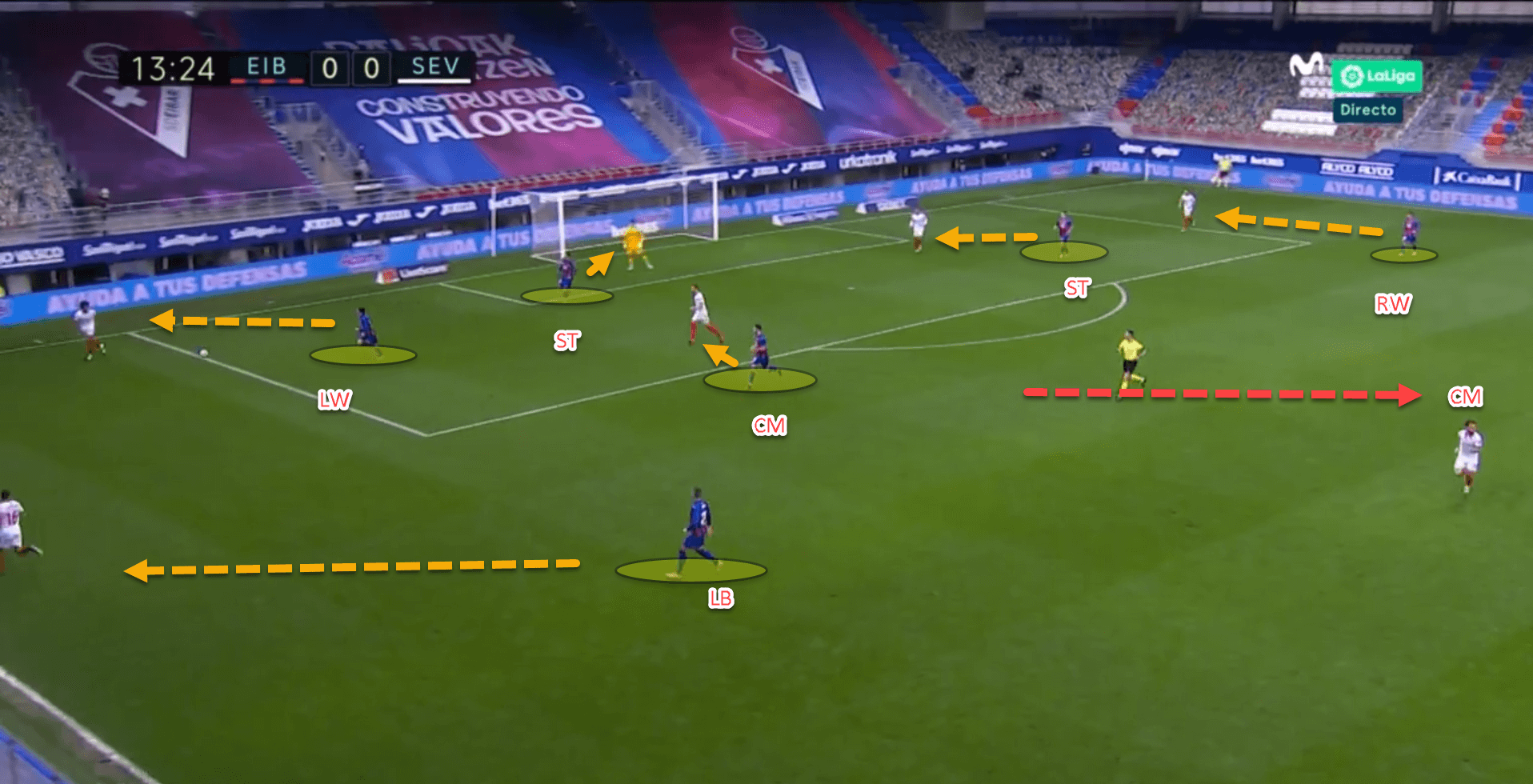
When the opposition switches the ball to the other side of the pitch, Eibar use a shifting defensive line and a staggering midfield line to force their opponents into making mistakes.
When the ball is switched, the ball-near fullback pushes up high and marks the opposition fullback/wingback. This is because the ball-near winger tucks inside to his nearest centre-back when the ball is over on the other side of the pitch, so when it is switched, he presses the centre-back instead of the fullback. The fullback is then free, so the Eibar fullback moves up to press his opposite number.
When this happens though, space is left down the channel of the fullback who has pushed up, so the rest of the backline shifts across to close the spaces, allowing the pressing structure to be secure on the ball-side.
The ball-near central midfielder also pushes up to close down the pivot player. However, the backline is staggered because the ball-far central midfielder drops deeper in order to protect the backline from the long ball, and the subsequent second balls.
Problems with the high-press
While Eibar’s pressing structure is impressive and persistent, there is a reason why they are so low down in the La Liga table as teams have still found ways around it. In this section, two creative solutions to bypassing the Spanish team’s high press will be highlighted.
Firstly, we will look at Real Madrid’s solution which includes inverting their nearest fullback and dropping the ball-near winger back into a right-back position, in what can only be described as an unconventional wide rotation.
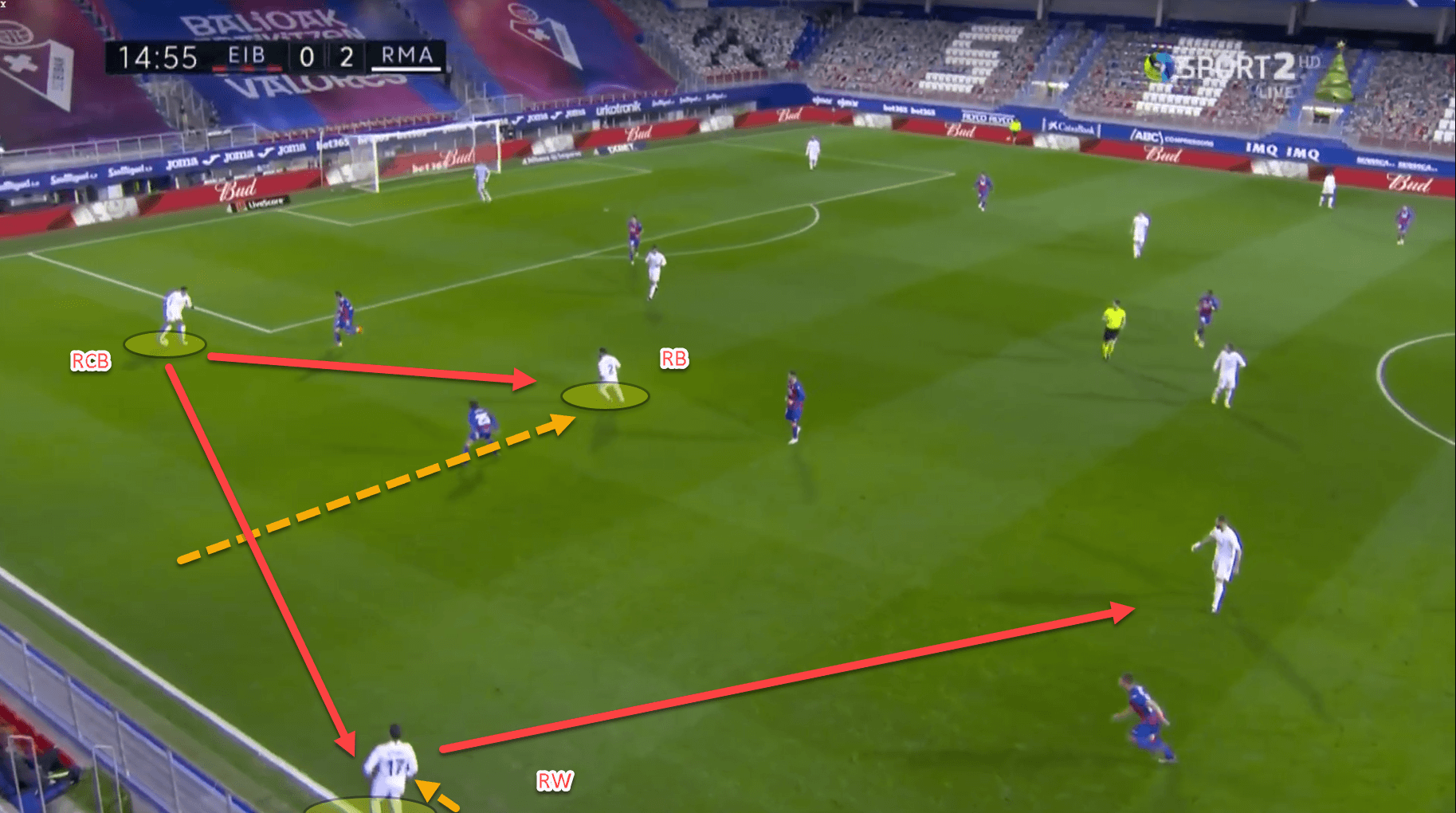
Generally, in a wide rotation, the winger inverts and the fullback pushes high and wide, but in this scenario, the ball-near fullback has inverted into the halfspace area of the pitch whilst the winger has dropped deep and occupied the right-back’s typical space.
The reason this was continuously so effective against Eibar in this game was because it all happened fluidly at a moment’s notice. When Real Madrid were struggling to bypass the press, Dani Carvajal would quickly invert, and Lucas Vasquez would drop. This disoriented Eibar’s pressing structure and players were unsure about who to press.
As we can see from this image, the Eibar left-winger in their 4-4-2 press was unsure whether to stay with Carvajal or move out to Vasquez, whilst the fullback was too slow to react, which allowed their opponents to play out from the back with ease at times.
Another creative solution to bypass Eibar’s intense and well-structured press came in a recent game against Levante. Levante used a 4-2-2-2 in the build-up and positional attack phases of play. They used a very well-detailed pattern of play in order to bypass Eibar’s press and quickly put them through on goal.
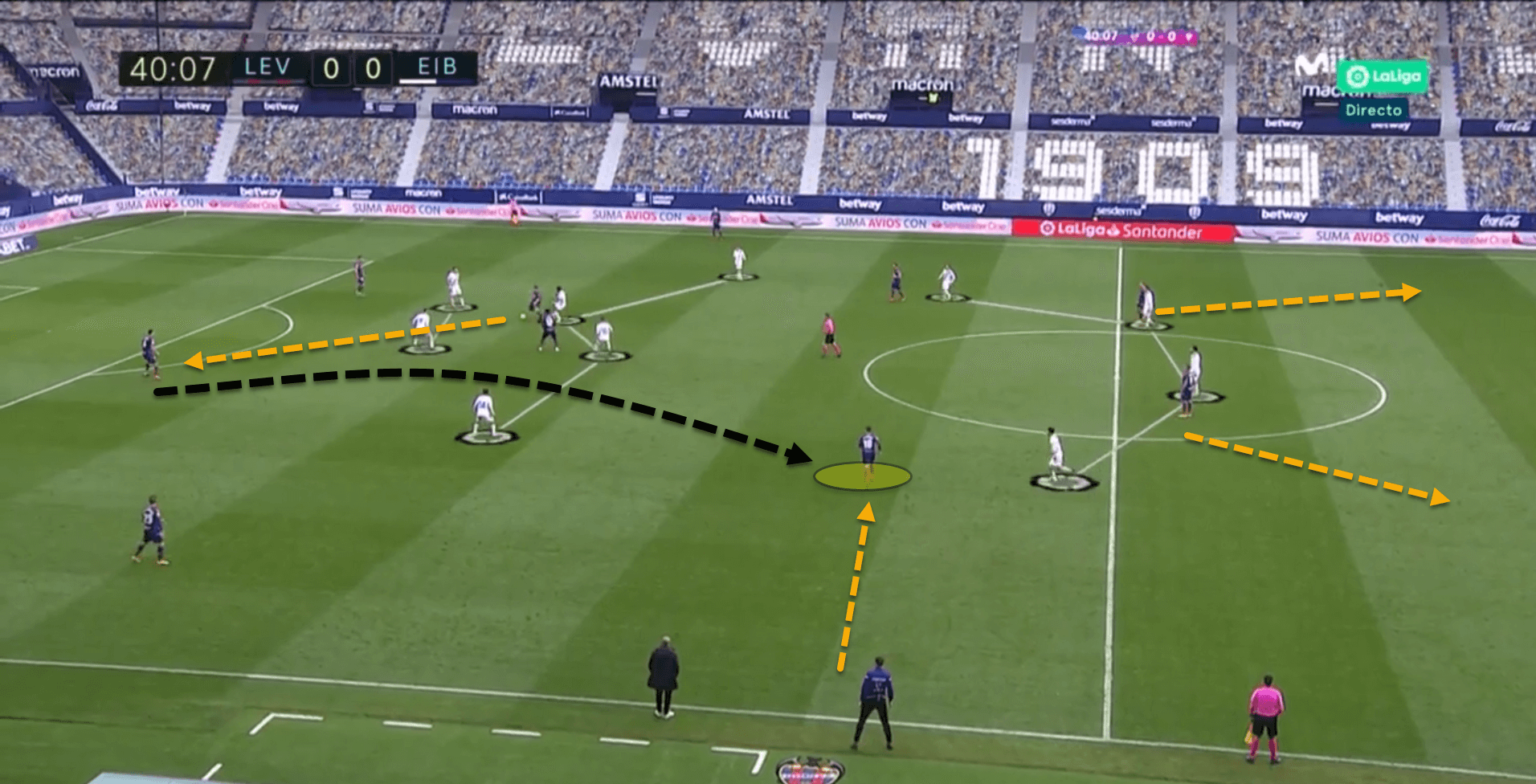
When the opposition have the ball with their backline and are playing with a double-pivot, Eibar generally use their first line of pressure of two strikers to press the centre-backs but also to cover shadow the double-pivot behind them.
However, when the first line of pressure is broken, they push their midfield up to quickly close down the ball-carrier and his partner in the double-pivot before they can turn on the ball and play forward. This subsequently leaves a lot of space behind the midfield line.
Levante used this to their advantage by using the double-pivot to act as wall passes back to the centre-backs when the first line of pressure was broken. In this scenario, the ball-carrier bounces the ball to the centre-back after receiving it behind Eibar’s two centre-forwards. The ball-near winger moves into the space between the lines as he has a lot of space to receive now.
Eibar’s midfield have pushed up and when the centre-back receives the ball, he instantly plays directly to the player who has moved in between the lines. This player is free to take a touch and play forward because Levante’s two strikers have positioned themselves in the channel between the fullback and centre-back, pinning all four players in the backline.
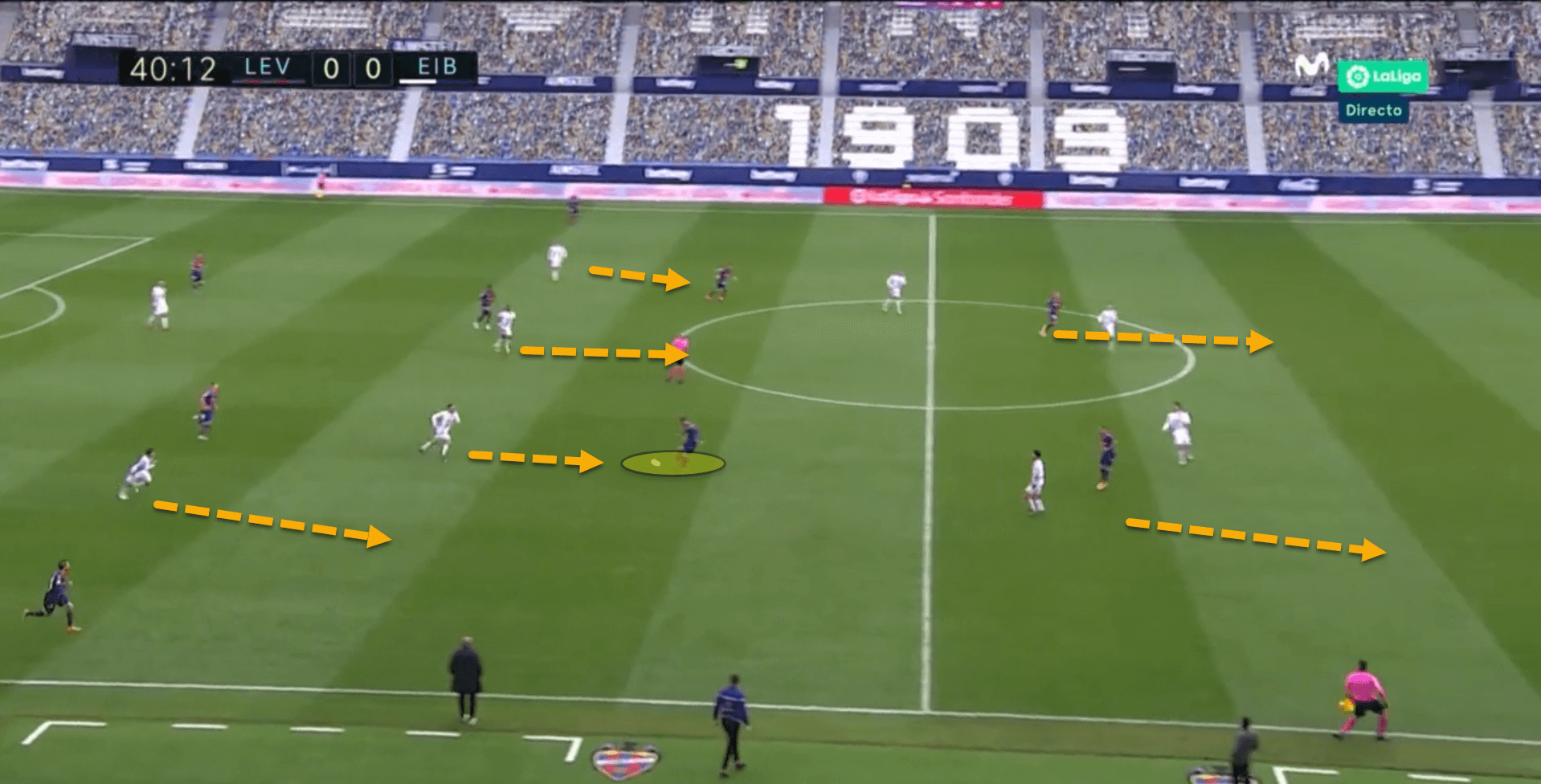
In this image, we can see the result of this creative pattern of play by Levante. Eibar’s fullback can’t come as he must protect the centre-back from the striker running into the channel, whilst the midfield is scrambling to support the backline and prevent the danger from happening.
Pressing with a three-man midfield
We spoke previously towards the beginning of the article about how Eibar’s most used systems in La Liga this season have been the 4-4-2 and the 4-2-3-1. However, against opponents that like to overload the central corridors, Mendilibar also tends to deploy a three-man midfield, and in particular, the 4-1-4-1.
When using a 4-1-4-1, the pressing structure changes ever so slightly and they also tend to drop off a bit into more of a compact mid-block in the centre of the pitch. In their 4-1-4-1, Eibar maintain the same defensive principle of pressing with two players in their first line of pressure and so push the ball-near central midfielder out to close down the opposition’s centre-back from the front whilst blocking the passing lane in behind him. This is called pressing frontally.
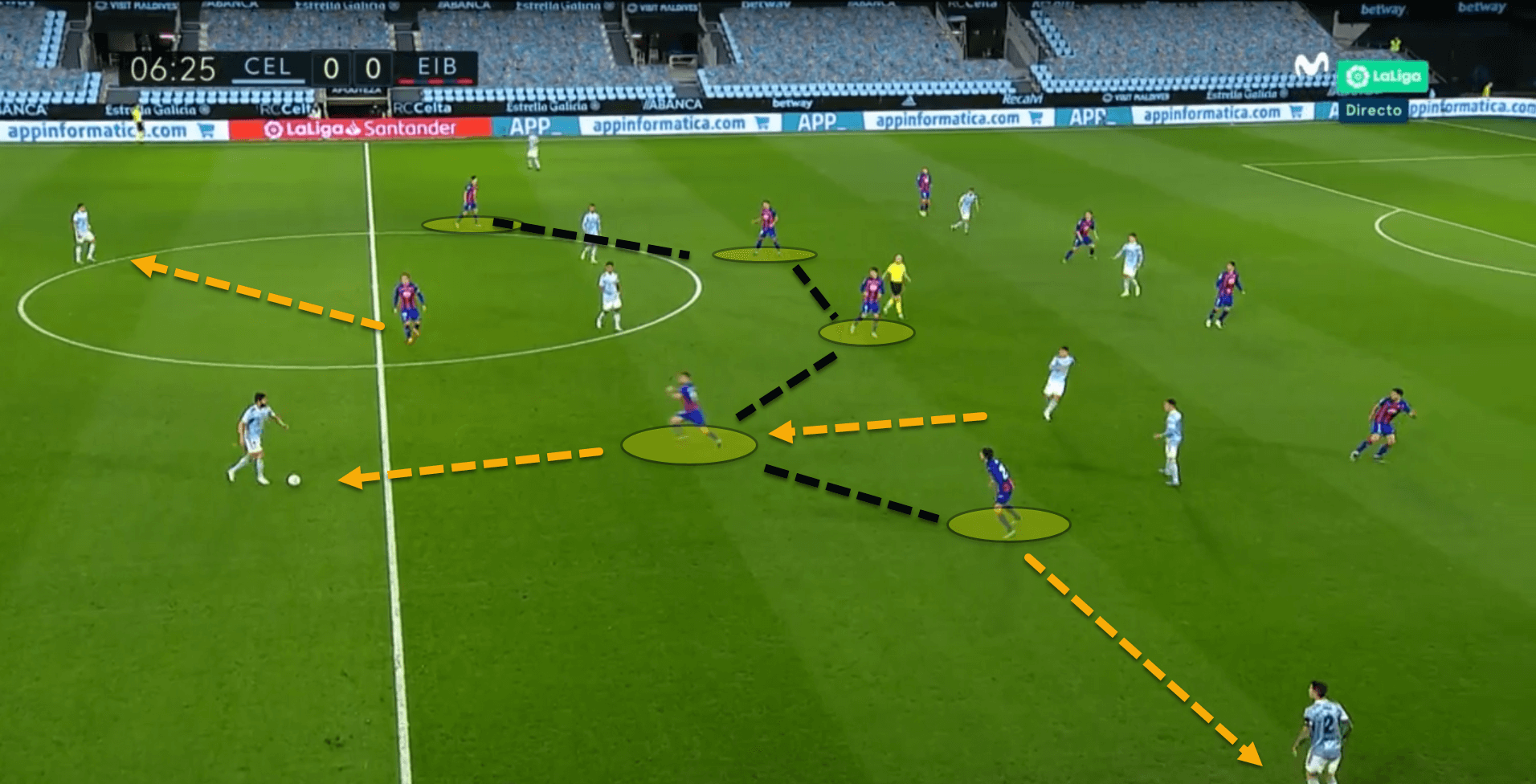
In this image, from a recent game against Celta Vigo, we can see this defensive principle being applied. Celta Vigo have positioned a lot of players in the central corridors, particularly between the lines, but Mendilibar had anticipated this by deploying a 4-1-4-1.
In a 4-1-4-1, there is only one lone striker pressing and so the ball-near central midfielder moves out to close down the centre-backs also alongside the centre-forwards. To do this though, as we can see from the image above, he must press the centre-back frontally, blocking the passing lane in behind.
While he does this, the other four midfield players close the gap he has left, and the shape again looks similar to a 4-4-2. This allows them to keep tight in midfield and make sure they do not get overrun, while also pressing the centre-backs with a two-man first line of pressure. We can see this again here:
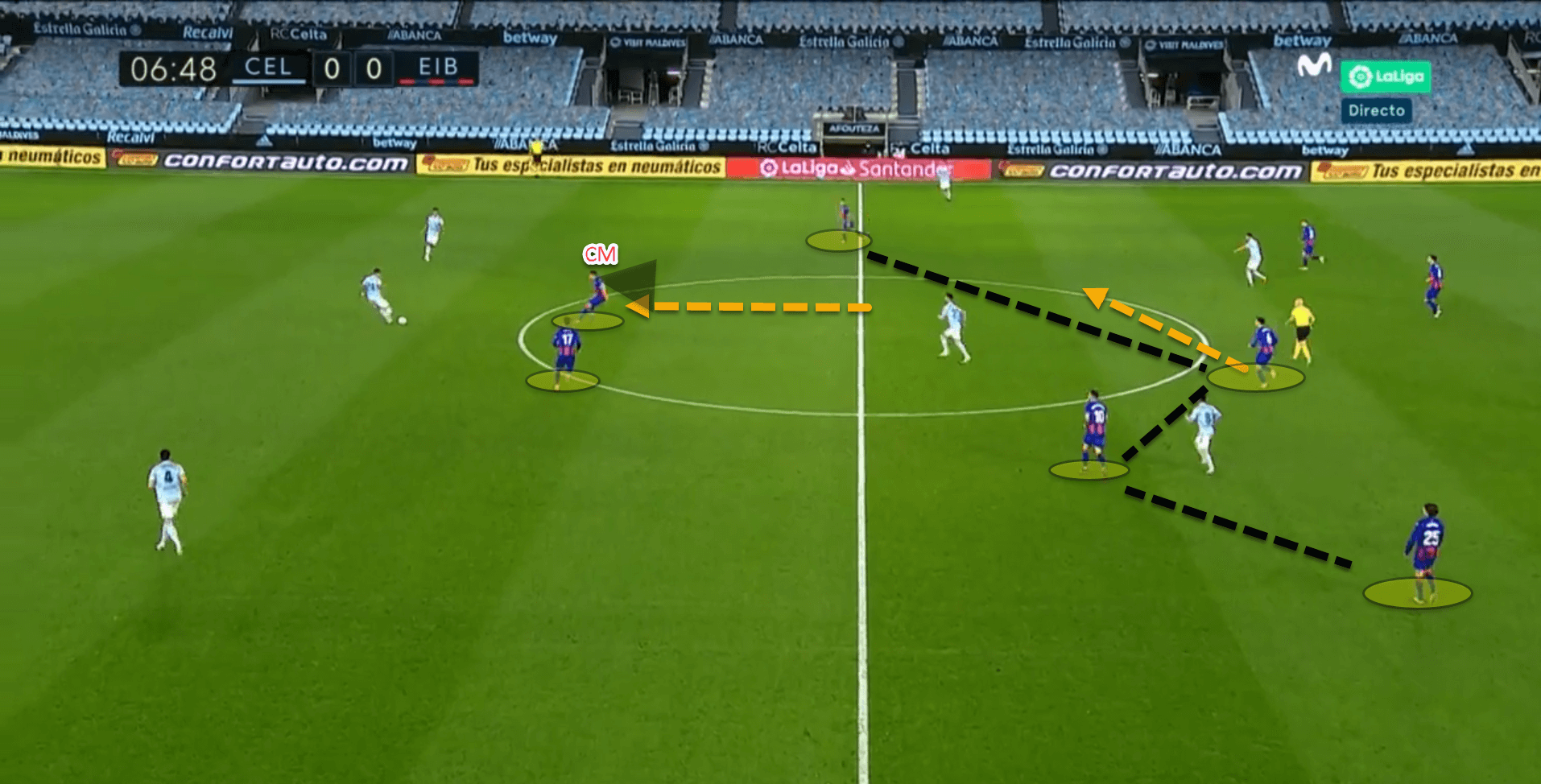
However, this only counts for when the ball is in the central areas of the pitch. When it is out wide, the ball-far winger pushes up and marks one of the centre-backs as it is not viable for a central midfielder to do this.
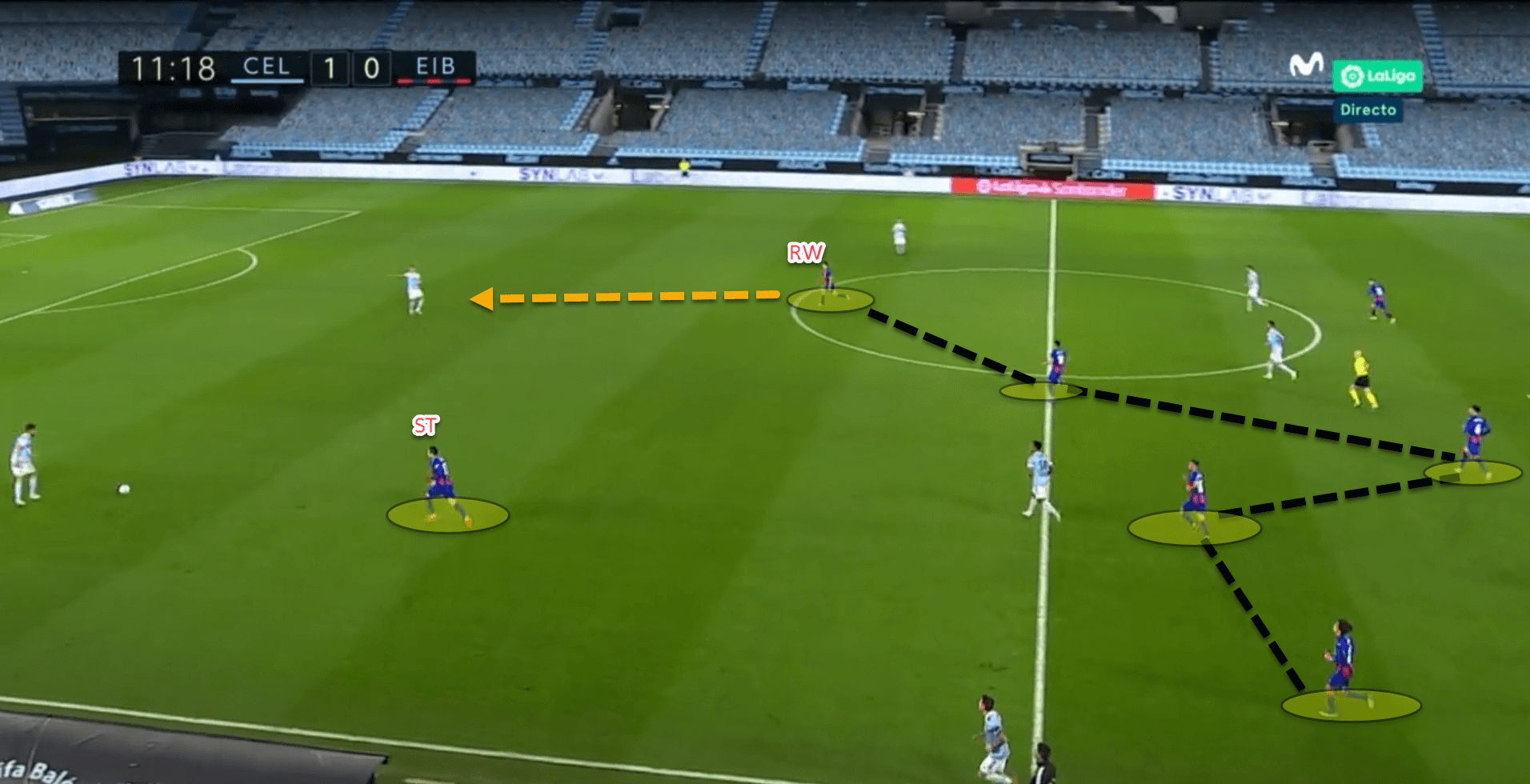
In this scenario, the ball-far winger has pushed up to press the other centre-back instead of a central midfielder and by doing so forces the ball-carrier to play back to the goalkeeper.
By pushing up the winger in this scenario, it cuts off the far side of the pitch and also allows them to maintain their two-man first line of pressure.
Conclusion
Eibar’s pressing system is one of the most intriguing and most effective in Europe’s top five leagues and has been for quite a few seasons now. They have conceded just 28 goals in La Liga this season, which is the eight-best defensive record in the top-flight division. However, they have scored just 20, which is the third-lowest goal tally, so it is clearly not their pressing system or defensive capabilities letting them down in this campaign.
Eibar are currently 16th, level on points with Deportivo Alaves in 18th, so if Mendilibar manages to keep them in the league this season and bolster their attack, whilst maintaining their solid and exciting pressing structure which we just analysed, the Spanish club could possibly become a top ten club once more.






Comments